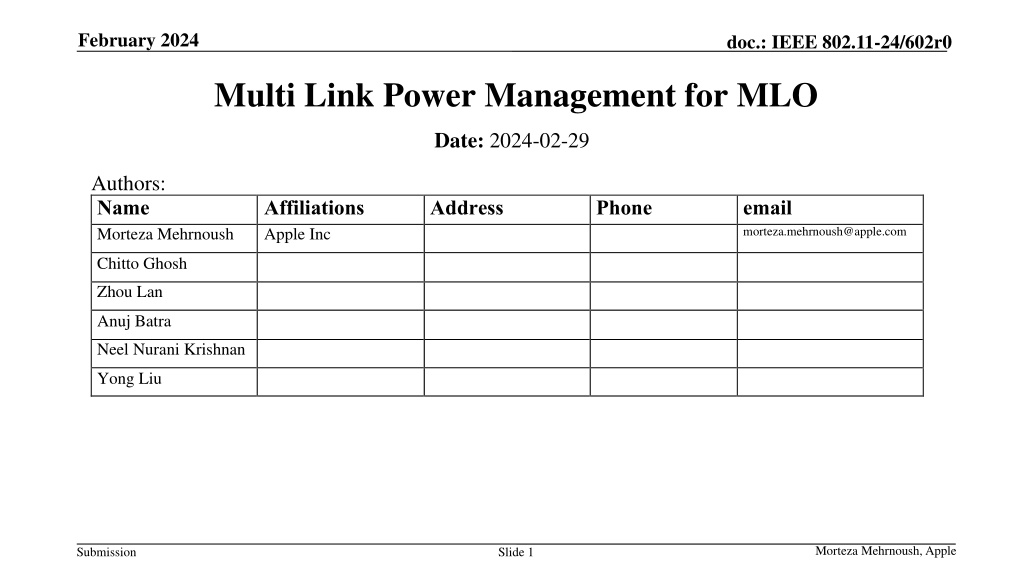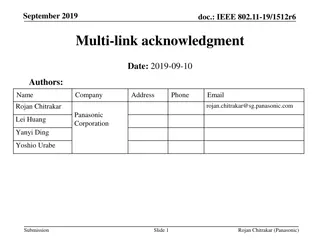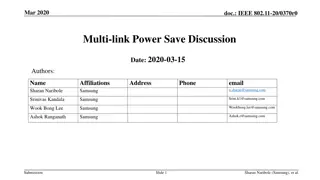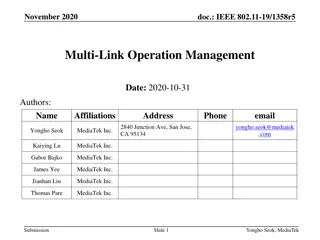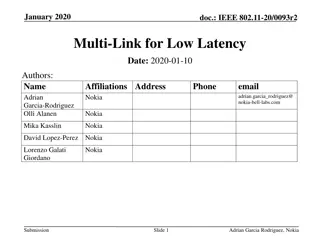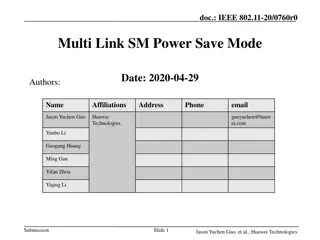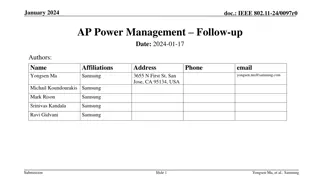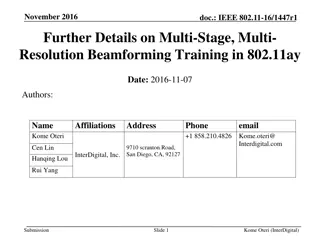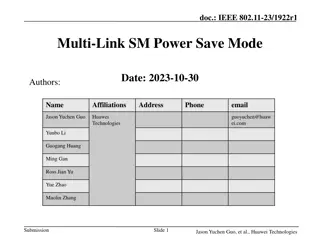Improving Multi-Link Power Management Efficiency in IEEE 802.11 Networks
The document discusses challenges with per-link power mode changes in multi-link scenarios in IEEE 802.11 networks, proposing a solution for more efficient power management. It addresses issues such as latency and inefficiencies in signaling for power mode changes, introducing scheduled multi-link power mode indication with timing information to enhance cross-link information exchange. The goal is to streamline the process of entering power-saving modes for non-AP MLDs and optimize power management operations for improved network performance.
- Multi-link power management
- IEEE 802.11
- Efficiency improvement
- Cross-link information exchange
- Power-saving modes
Download Presentation

Please find below an Image/Link to download the presentation.
The content on the website is provided AS IS for your information and personal use only. It may not be sold, licensed, or shared on other websites without obtaining consent from the author. Download presentation by click this link. If you encounter any issues during the download, it is possible that the publisher has removed the file from their server.
E N D
Presentation Transcript
February 2024 doc.: IEEE 802.11-24/602r0 Multi Link Power Management for MLO Date: 2024-02-29 Authors: Name Morteza Mehrnoush Affiliations Apple Inc Address Phone email morteza.mehrnoush@apple.com Chitto Ghosh Zhou Lan Anuj Batra Neel Nurani Krishnan Yong Liu Morteza Mehrnoush, Apple Submission Slide 1
February 2024 doc.: IEEE 802.11-24/602r0 Introduction Currently the PM mode change is per-link and cross link PM mode change is not possible: When a non-AP MLD wants to enter the PS mode on all the links, it has to do a frame exchange over each of the enabled links separately Per-link frame exchange to change PM mode is inefficient and it could cause long delay for STAs of non-AP MLD to enter PS mode and go to doze state In Wi-Fi 7 some proposals are discussed: In [1] cross link PM mode change for the non-AP MLD by using the A-Control field is proposed; 1bit for the PM mode and 16 bitmap to indicate the link-ID(s) where PM changes applies to In [2,3], an alternative proposal is discussed in which a non-AP MLD indicates that the other link (cross link indication) is in awake state during PS mode and it s ready to receive the DL by using PS-Poll or QoS-Null All these proposals were considering the immediate cross link information delivery and due to cross link information exchange delay between the APs of AP MLD, the group could not get consensus to agree on a solution In this proposal, scheduled multi link PM mode indication with timing information is introduced to address the cross link information exchange delay between the APs of AP MLD Also, when non-AP MLD switches to PS mode, it may include the duration information of the STA remaining in the PS mode Submission Slide 2 Morteza Mehrnoush, Apple
February 2024 doc.: IEEE 802.11-24/602r0 Current PM Mode Change in MLD Case Latency and inefficiency of per-link signaling: Case-1: L1, L2, and L3 are STR links Frame exchange over each link separately to change PM mode The delay considering the OBSS and contention could be non-trivial Case-2: L1 is STR link, L2 and L3 are EMLSR links There is extra latency for frame exchange in UL over EMLSR links for PM indication due to EMLSR limitations Non-AP MLD in order to go to sleep state at T0, it needs to send PM=1 over each link earlier This causes AP-1 and AP-2 to stop sending DL traffic earlier than needed during t-1 and t-2 which prevents using L1 and L2 during this periods QN: QoS-Null Submission Slide 3 Morteza Mehrnoush, Apple
February 2024 doc.: IEEE 802.11-24/602r0 Scheduled Multi Link PM Mode Indication This proposal enables the multi-link PM mode indication through single frame exchange which decreases the overhead and latency of PM mode change Signaling fields needed for scheduled PM mode indication: Link-ID(s) and PM bit per-link: the link(s) and the PM indication over each link Schedule Time: the time in future where the PM mode change should be applied to Non-AP MLD uses the Schedule Time to give scheduled PM mode change indication to the AP MLD in the future; this timing could be absolute timing (e.g. TSF) or time offset AP MLD s expected cross link information exchange delay should be sent to the non-AP MLDs during the association or through the EML OMN req/res mechanism non-AP MLDs should set the Schedule Timing to meet the cross link information exchange delay Duration: the duration where the STA remaining in PS mode Non-AP MLD might want to indicate the duration remaining in PS mode; after this duration non-AP MLD returns to Active mode This reduces the extra signaling overhead, i.e. PM=0 indication, in order to return to Active mode Scheduled Multi Link PM Signaling The multi link PM signaling information can be carried in a Control frame or a lighter version of the signaling in A-Control Field Slide 4 Submission Morteza Mehrnoush, Apple
February 2024 doc.: IEEE 802.11-24/602r0 Multi Link PM Mode Indication Scenario Non-AP MLD in order to switch to PS mode on all the links, sends a PMI frame on L2 (STA-2) by including: link-IDs=1/2/3, PM=1 for all the links, and Schedule Timing to indicate when the PS mode will take effect When AP-2 receives the PMI frame, it sends the ACK and AP MLD considers all STAs of non-AP MLD are in PS mode at t=T0 Submission Slide 5 Morteza Mehrnoush, Apple
February 2024 doc.: IEEE 802.11-24/602r0 Other Clarifications for Multi Link PM Addressing the AP MLD architectures that are not truly MLD between 2.4GHz and 5/6GHz: Some AP MLDs implementation does not consider 2.4GHz link as part of MLD architecture, so the cross link information exchange delay between 2.4GHz and 5/6GHz APs is much longer In order to accommodate such architectures, AP MLD can indicate the links which it can support the cross link signaling but not all the enabled links Maximum cross link information exchange delay requirement: If the cross link information exchange delay is very long, the non-AP MLD doesn t benefit from the scheduled multi link PM indication, i.e., instead it can contend over each link separately to indicate PM mode change If cross link information exchange delay is less than 5ms it will be useful STAs of the non-AP MLD can use the PM bit in Frame Control field for the same link along with the multi link PM Similar to legacy this will be in effect immediately after receiving the ACK Preventing the race condition: If a STA of non-AP MLD, which is operating on one link, sent the cross link PM mode change on behalf of the other STA, the other STA can send the PM bit over its own link but it should be the same PM value as the one sent in cross link PM signaling Slide 6 Submission Morteza Mehrnoush, Apple
February 2024 doc.: IEEE 802.11-24/602r0 Leaky AP Issue Currently some APs may have leaky AP issue: When the STAs indicate the PM=1 and go to power save, it takes time for the AP to take the STA s PM=1 indication into account and so it keeps sending DL traffic We need to prevent such a case in multi link PM indication: There should be a mandatory rule to make sure AP MLD after the scheduled time won t send any packets to the STAs that are indicated to be in PS mode Similarly exiting PS mode is important: It s undesirable for AP MLD to take a considerable amount of time before being able to deliver packets on all the links The optional Duration field can help such a scenario; the AP MLD can transmit packets to the STA in all the links after this Duration, i.e. STA enters Active mode If the STA indicates the Duration of staying in PS mode but decides to exit PS mode earlier, it is still allowed to send a frame containing Active mode indication Submission Slide 7 Morteza Mehrnoush, Apple
February 2024 doc.: IEEE 802.11-24/602r0 Summary We discussed the use cases of multi link PM and proposed a solution which allows a faster and more efficient way of PM mode change across links The proposal provides scheduled PM mode indication to help the AP MLD to meet the cross link information exchange delay To enable the multi link PM, AP MLD needs to announce its expected cross link information exchange delay to associated non-AP MLDs Submission Slide 8 Morteza Mehrnoush, Apple
February 2024 doc.: IEEE 802.11-24/602r0 References [1] 802.11be-20/1544r5, Multi-Link Power Save Link Bitmap, Minyoung Park, et al [2] 802.11be-19/1857r1, Multi-Link Power Save follow up, Liwen Chu, et al [3] 802.11be-22/1205r4, indicating to operate in EML mode via PS-Poll or QoS-Null, Xiangxin Gu, et al Submission Slide 9 Morteza Mehrnoush, Apple
